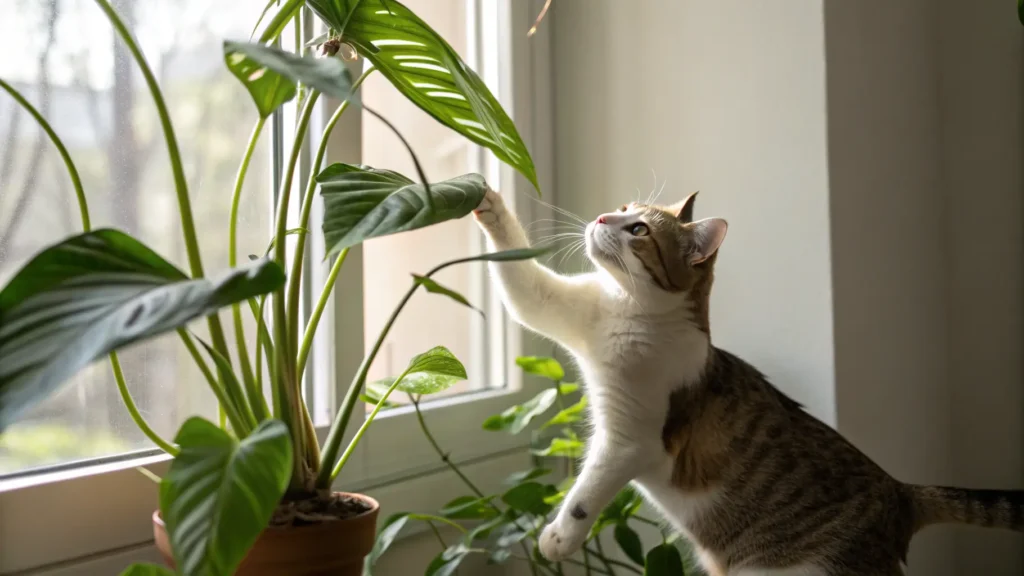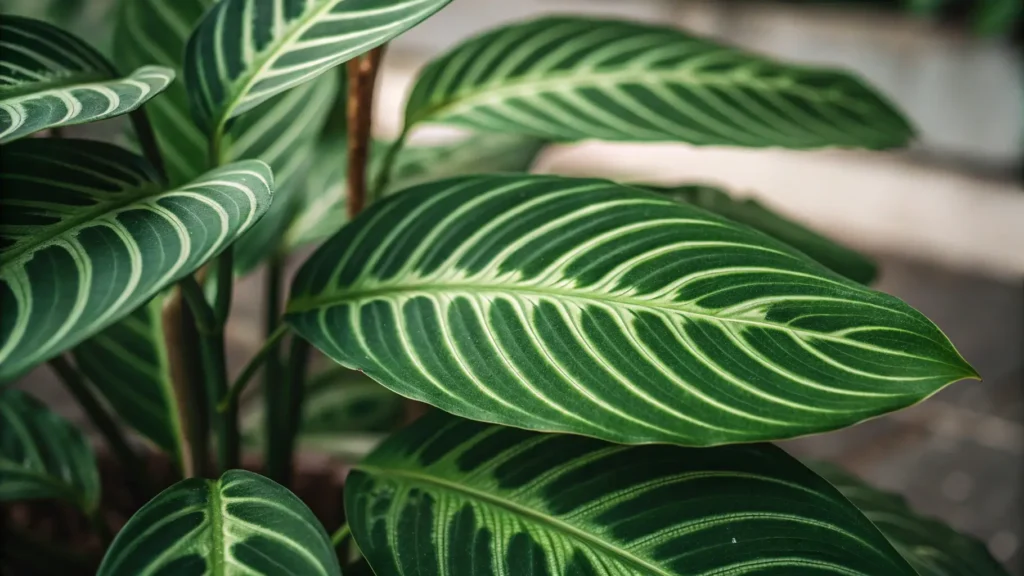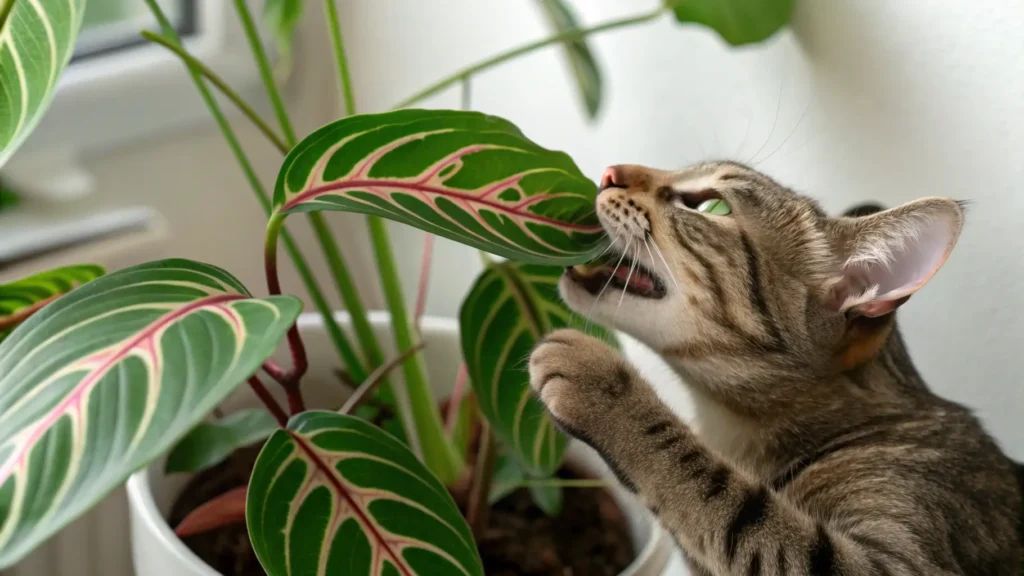you ever wondered why do cats like prayer plants so much? You’re not alone. Many cat parents watch with a mix of amusement and concern as their feline friends bat at, chew on, or even nap beside these captivating houseplants. Prayer plants, with their distinctive daily leaf movements, hold a unique appeal for curious cats. But beyond their charm, what drives this feline fascination, and more importantly, are these popular plants safe for your beloved pet?
This comprehensive guide will unravel the mystery of your cat’s obsession, provide the definitive answers on prayer plant toxicity, and equip you with expert-backed strategies to ensure both your green companions and furry family members thrive safely. We’ll explore the irresistible allure of these plants and offer practical, step-by-step solutions to manage your cat’s interactions, making this the ultimate resource for understanding why do cats like prayer plants.
TABLE OF CONTENTS
The Irresistible Allure: Why Cats Are Drawn to Prayer Plants
Prayer plants (Maranta leuconeura) possess a unique combination of characteristics that make them particularly enticing to cats. Their dynamic nature, interesting textures, and even the simple fact of being a new object in their environment can trigger a cat’s innate curiosity and play drive. Understanding these specific attractions is the first step in managing your cat’s interaction with them.
The Dynamic Dance: Leaf Movement as a Stimulant
One of the most captivating features of prayer plants is their nyctinasty – the rhythmic folding up of their leaves at night and unfolding during the day. This constant motion can be incredibly stimulating for cats. It mimics the subtle movements of prey, triggering their hunting instincts and making the plant seem like an engaging, living toy.

According to Dr. Sarah Evans, a feline behaviorist, “Cats are hardwired predators. Anything that moves, even subtly, captures their attention and stimulates their innate hunting behaviors. The prayer plant’s daily dance is like a slow-motion twitching mouse to them.”
Textural Temptation: The Feel of Prayer Plant Leaves
Prayer plants often feature soft, velvety, or slightly crinkly leaves. This unique texture can be highly appealing to a cat’s sensitive paws and mouth. They might enjoy batting at the leaves, rubbing against them, or gently chewing to explore the sensation. This sensory exploration is a natural part of how cats interact with their environment.

Taste and Curiosity: Exploring a New Flavor
When a new plant enters a cat’s territory, it’s natural for them to investigate it with all their senses, including taste. While prayer plants don’t have a strong or particularly appealing flavor to humans, a cat’s curiosity might lead them to take a nibble. It’s often more about exploration than a desire for nutrition.

Boredom Busters: When Plants Become Toys
For an under-stimulated cat, anything can become a source of entertainment. A prayer plant, with its moving leaves, tempting textures, and new presence, can easily become an accessible toy. Chewing, batting, or pouncing on plants can be a sign that your cat needs more interactive play or environmental enrichment.
Hydration Hunters: Droplets and Dew
Prayer plant leaves can sometimes accumulate water droplets, either from misting or condensation. Some cats are fascinated by water and might be drawn to these droplets, attempting to lick or bat at them. This could be a playful interaction or a subtle attempt to access hydration, especially if they prefer fresh, moving water.
Are Prayer Plants Toxic to Cats? The Definitive Answer
Beyond understanding why do cats like prayer plants, the most pressing question for any responsible pet owner is always about safety. The good news is, for the primary species commonly known as prayer plant, the definitive answer is reassuring.
ASPCA & Expert Consensus: Is it Safe or Not?
According to authoritative sources like the American Society for the Prevention of Cruelty to Animals (ASPCA), the common Prayer Plant (Maranta leuconeura) is generally considered non-toxic to cats. This means that if your cat takes a small nibble, it’s unlikely to cause severe poisoning. This consensus is widely supported by veterinarians and plant experts, offering peace of mind to many cat-owning plant enthusiasts. ASPCA.org
Potential Mild Symptoms: What to Watch For
While prayer plants are non-toxic, it’s important to understand that any plant material consumed in large quantities can potentially lead to mild gastrointestinal upset in sensitive cats. If your cat eats a significant amount of a prayer plant, you might observe temporary symptoms such as:
- Mild vomiting
- Diarrhea
- Decreased appetite
- Lethargy
These symptoms are typically short-lived and resolve on their own once the plant material passes through their system. However, continuous monitoring is always advised.
Differentiating Prayer Plant Varieties: Are All Safe? (Maranta, Calathea, Ctenanthe)
The term “prayer plant” is sometimes used broadly, encompassing a few closely related species known for their nyctinastic leaf movements. The good news continues: most plants within the Marantaceae family, including Calathea and Ctenanthe species, are also generally considered non-toxic to cats by the ASPCA. This means that if you have a variety like a Calathea Orbifolia or a Ctenanthe Burle-Marxii, your cat is likely still safe from severe poisoning.
It’s always wise to know the exact species of your houseplant. When in doubt, a quick check with the ASPCA’s comprehensive plant list or a local vet can provide specific guidance.
What to Do If Your Cat Eats a Prayer Plant (and Prevention)

Even though prayer plants are non-toxic, preventing your cat from eating them is ideal for both your plant’s longevity and your cat’s comfort. If you’ve observed your cat nibbling, knowing the immediate steps to take, alongside effective deterrents and enrichment strategies, is crucial.
Immediate Steps: When to Call the Vet
If you see your cat eating a prayer plant, don’t panic. Since they are non-toxic, severe reactions are rare.
- Remove Access: Immediately remove your cat from the plant and relocate the plant to an inaccessible area.
- Observe Your Cat: Monitor your cat closely for any of the mild symptoms mentioned above (vomiting, diarrhea, lethargy).
- Offer Food and Water: Ensure your cat has access to fresh water and their regular food.
- Contact Your Vet If:
- Symptoms are severe or persistent (more than 24 hours).
- Your cat appears distressed or in pain.
- Your cat has underlying health conditions.
- You suspect your cat has ingested a different, potentially toxic plant.
For any concerns, it’s always best to err on the side of caution and consult your veterinarian or a pet poison control hotline.
Deterring Your Feline Friend: Practical Strategies
Preventing your cat from interacting with your prayer plants requires a multi-pronged approach.
Environmental Adjustments & Plant Placement
- High Shelves: Place plants on tall, sturdy shelves that your cat cannot jump onto.
- Hanging Baskets: Utilize hanging planters to keep plants completely out of reach.
- Closed Rooms: Keep plants in rooms that are off-limits to your cat.
- Terrariums or Plant Cages: For smaller plants, consider decorative cloches or wire cages.
Scent-Based Deterrents
Cats are sensitive to certain smells they find unpleasant.
- Citrus: Place orange, lemon, or lime peels around the base of the plant. Cats generally dislike citrus scents.
- Cayenne Pepper: A light dusting of cayenne pepper on the soil can deter curious sniffers (though be cautious as it can irritate paws and eyes if rubbed).
- Commercial Sprays: Many pet stores offer bitter-tasting or scent-based deterrent sprays designed for plants. Always test on a small, inconspicuous leaf first.
- Coffee Grounds: Sprinkling used coffee grounds in the soil can deter some cats due to the strong smell.
Physical Barriers & Protectors
- Pebble Toppers: Covering the soil with large, smooth pebbles can discourage digging and chewing on soil or roots.
- Foil or Mesh: Place aluminum foil or chicken wire around the base of the plant to make the area less appealing.
- Plant Stands with Fencing: Some plant stands come with small fences or can be adapted to include them.
Enriching Your Cat’s Environment: Safe Alternatives
Often, a cat’s interest in houseplants stems from boredom or a lack of appropriate outlets for their natural instincts. Providing appealing alternatives can significantly reduce their desire to chew on your prayer plants.
Cat Grass & Other Feline-Friendly Plants
Offer your cat their own safe plants to munch on.
- Cat Grass: Easy to grow and a healthy, appealing alternative for cats who like to chew greens.
- Spider Plant: Non-toxic and often a favorite for cats to play with.
- Oat Grass, Wheat Grass, Barley Grass: All safe and enjoyable for cats.
Interactive Toys & Playtime
Engage your cat’s hunting instincts with regular play sessions.
- Puzzle Feeders: Challenge their minds and provide mental stimulation.
- Feather Wands: Mimic prey and encourage pouncing and chasing.
- Laser Pointers: Offer a fun chase (remember to end with a tangible toy so they can “catch” their prey).
- Automatic Toys: Provide entertainment when you’re not available.
Vertical Spaces & Scratching Posts
Provide opportunities for climbing, scratching, and exploring.
- Cat Trees: Offer multiple levels for climbing, perching, and scratching.
- Wall Shelves: Create vertical pathways for exploration.
- Scratching Posts: Ensure various textures (sisal, cardboard, carpet) to satisfy scratching needs.
Beyond Prayer Plants: General Houseplant Safety for Cats
While understanding why do cats like prayer plants and their safety is key, a truly cat-safe home extends to all your houseplants. Being aware of common toxic plants and actively choosing safe alternatives will create a harmonious environment for both your botanical and feline family members.
Common Toxic Houseplants to Avoid
Many popular houseplants are beautiful but unfortunately toxic to cats. Always verify a plant’s toxicity before bringing it home. Here are a few common ones to be particularly wary of:
- Lilies: Extremely toxic and potentially fatal, even small amounts.
- Sago Palm: Highly toxic, can cause liver failure.
- Daffodils, Tulips, Hyacinths: The bulbs are particularly dangerous.
- Aloe Vera: While beneficial for humans, it can cause vomiting and diarrhea in cats.
- Pothos (Devil’s Ivy), Philodendron: Can cause oral irritation and digestive upset.
- Dieffenbachia (Dumb Cane): Causes intense oral pain and swelling.
- Oleander: Highly toxic to the heart.
Identifying Cat-Safe Plants for Your Home
Fortunately, there are many beautiful and non-toxic houseplants that you can enjoy without worry. Here are a few excellent choices:
- African Violet: Colorful and safe.
- Christmas Cactus: A festive and pet-friendly option.
- Boston Fern: A classic, non-toxic choice.
- Money Tree (Pachira aquatica): A popular office plant that’s safe for cats.
- Areca Palm: A great non-toxic option for a larger plant.
- Orchids: Generally considered safe and elegant.
Frequently Asked Questions About Cats and Prayer Plants
We’ve covered a lot about why do cats like prayer plants and how to keep them safe. Here are some quick answers to other common questions you might have.
How much prayer plant is too much for a cat to eat?
Since prayer plants are non-toxic, there isn’t a specific “dangerous” amount. However, any significant consumption can cause mild digestive upset. If your cat eats more than a few leaves, monitor for symptoms like vomiting or diarrhea. If these are severe or persist, contact your vet.
Do cats eat prayer plants because they are lacking nutrients? (Debunking myths)
It’s a common myth that cats eat plants due to a nutritional deficiency. While cats are carnivores and don’t derive significant nutrients from plants, their plant-eating behavior is more often linked to curiosity, boredom, the urge to purge hairballs, or simply a desire for texture and play. Offering cat grass can satisfy this urge in a safe way.
Are there any benefits of prayer plants for cats? (Clarifying misconceptions)
No, prayer plants offer no known health benefits for cats. While they are non-toxic, they are not a food source or a beneficial supplement for your feline friend. Any ingestion is purely for exploratory or behavioral reasons.
Will my cat ever stop eating plants?
Some cats will always have an interest in plants. However, with consistent training, environmental enrichment, and providing appealing alternatives like cat grass and interactive toys, you can significantly reduce their desire to chew on your houseplants. Patience and consistency are key.
What if I can’t keep my cat away from plants?
If despite all deterrents and enrichment, your cat remains determined to eat your prayer plants or other houseplants, your best option is to keep those plants in rooms that are inaccessible to your cat. Ultimately, your cat’s safety should always be the priority.
Conclusion
Understanding why do cats like prayer plants is the first step toward a harmonious home where both your plants and pets can thrive. From their captivating leaf movements to their tempting textures, prayer plants offer an undeniable allure for curious felines. The good news is that these charming plants are generally non-toxic, offering peace of mind to worried pet parents.
